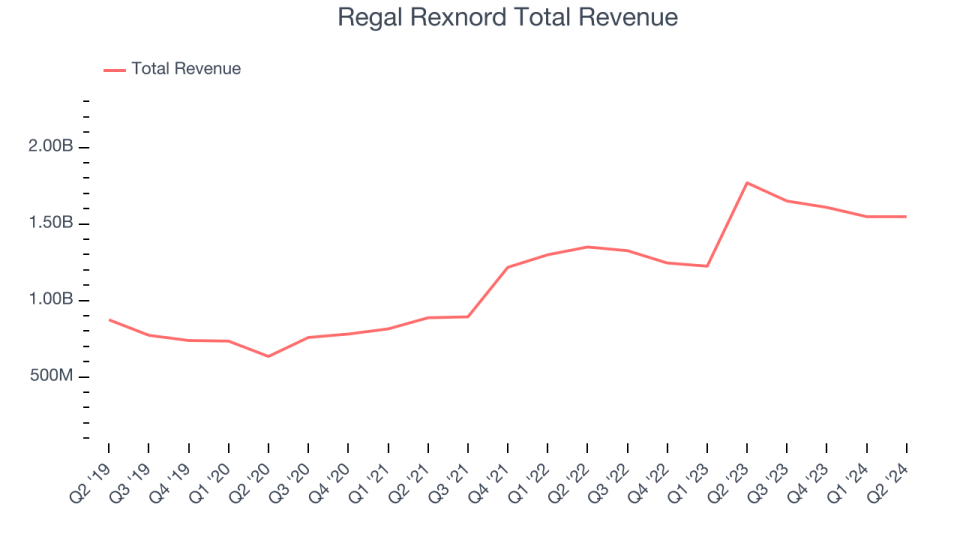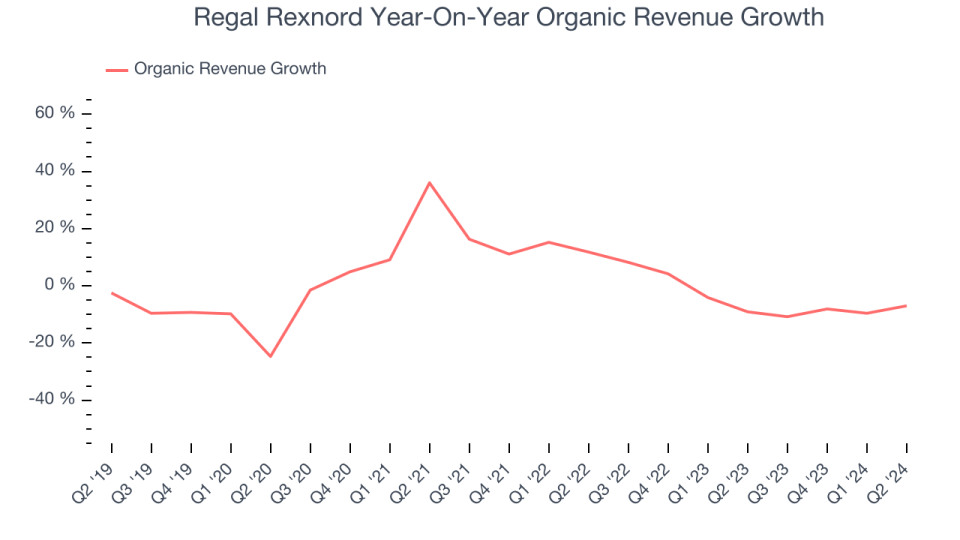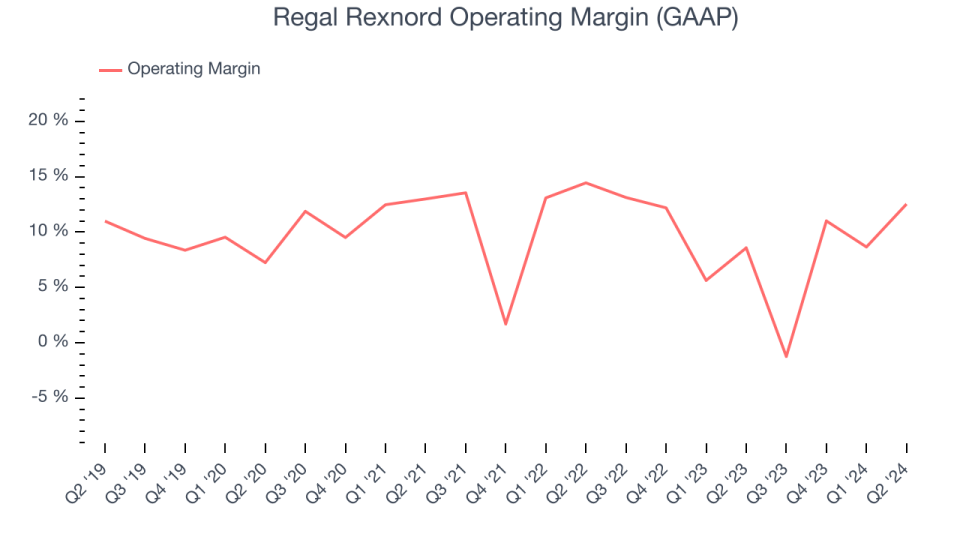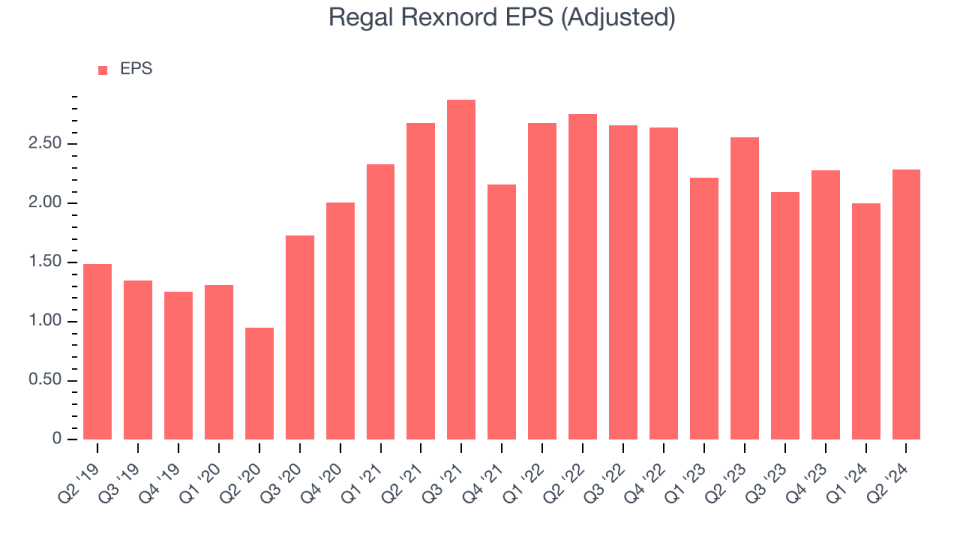Regal Rexnord (NYSE:RRX) Exceeds Q2 Expectations

Industrials products and automation company Regal Rexnord (NYSE:RRX). announced better-than-expected results in Q2 CY2024, with revenue down 12.5% year on year to $1.55 billion. It made a non-GAAP profit of $2.29 per share, down from its profit of $2.56 per share in the same quarter last year.
Is now the time to buy Regal Rexnord? Find out in our full research report.
Regal Rexnord (RRX) Q2 CY2024 Highlights:
Revenue: $1.55 billion vs analyst estimates of $1.51 billion (2.7% beat)
EPS (non-GAAP): $2.29 vs analyst estimates of $2.13 (7.4% beat)
EPS (non-GAAP) Guidance for the full year is $9.60 at the midpoint, roughly in line with what analysts were expecting
Gross Margin (GAAP): 36.9%, up from 32.5% in the same quarter last year
Free Cash Flow of $125.9 million, up 94.9% from the previous quarter
Organic Revenue fell 7% year on year (-9.1% in the same quarter last year)
Market Capitalization: $10.54 billion
Headquartered in Milwaukee, Regal Rexnord (NYSE:RRX) provides power transmission and industrial automation products.
Engineered Components and Systems
Engineered components and systems companies possess technical know-how in sometimes narrow areas such as metal forming or intelligent robotics. Lately, automation and connected equipment collecting analyzable data have been trending, creating new demand. On the other hand, like the broader industrials sector, engineered components and systems companies are at the whim of economic cycles. Consumer spending and interest rates, for example, can greatly impact the industrial production that drives demand for these companies’ offerings.
Sales Growth
Reviewing a company's long-term performance can reveal insights into its business quality. Any business can have short-term success, but a top-tier one tends to sustain growth for years. Luckily, Regal Rexnord's sales grew at an excellent 12.4% compounded annual growth rate over the last five years. This shows it expanded quickly, a useful starting point for our analysis.

We at StockStory place the most emphasis on long-term growth, but within industrials, a half-decade historical view may miss cycles, industry trends, or a company capitalizing on catalysts such as a new contract win or a successful product line. Regal Rexnord's annualized revenue growth of 15.6% over the last two years is above its five-year trend, suggesting its demand was strong and recently accelerated.
We can dig further into the company's sales dynamics by analyzing its organic revenue, which strips out one-time events like acquisitions and currency fluctuations because they don't accurately reflect its fundamentals. Over the last two years, Regal Rexnord's organic revenue averaged 4.5% year-on-year declines. Because this number is lower than its normal revenue growth, we can see that some mixture of acquisitions and foreign exchange rates boosted its headline performance.

This quarter, Regal Rexnord's revenue fell 12.5% year on year to $1.55 billion but beat Wall Street's estimates by 2.7%. Looking ahead, Wall Street expects revenue to decline 3.1% over the next 12 months.
Here at StockStory, we certainly understand the potential of thematic investing. Diverse winners from Microsoft (MSFT) to Alphabet (GOOG), Coca-Cola (KO) to Monster Beverage (MNST) could all have been identified as promising growth stories with a megatrend driving the growth. So, in that spirit, we’ve identified a relatively under-the-radar profitable growth stock benefitting from the rise of AI, available to you FREE via this link.
Operating Margin
Operating margin is an important measure of profitability as it shows the portion of revenue left after accounting for all core expenses–everything from the cost of goods sold to advertising and wages. It's also useful for comparing profitability across companies with different levels of debt and tax rates because it excludes interest and taxes.
Regal Rexnord has done a decent job managing its expenses over the last five years. The company has produced an average operating margin of 9.5%, higher than the broader industrials sector.
Looking at the trend in its profitability, Regal Rexnord's annual operating margin decreased by 1.1 percentage points over the last five years. Even though its margin is still high, shareholders will want to see Regal Rexnord become more profitable in the future.

In Q2, Regal Rexnord generated an operating profit margin of 12.5%, up 4 percentage points year on year. Since its gross margin expanded more than its operating margin, we can infer that leverage on its cost of sales was the primary driver behind the recently higher efficiency.
EPS
Analyzing long-term revenue trends tells us about a company's historical growth, but the long-term change in its earnings per share (EPS) points to the profitability of that growth–for example, a company could inflate its sales through excessive spending on advertising and promotions.
Regal Rexnord's EPS grew at a decent 8.5% compounded annual growth rate over the last five years. However, this performance was lower than its 12.4% annualized revenue growth, telling us the company became less profitable on a per-share basis as it expanded.

Diving into Regal Rexnord's quality of earnings can give us a better understanding of its performance. As we mentioned earlier, Regal Rexnord's operating margin improved this quarter but declined by 1.1 percentage points over the last five years. This was the most relevant factor (aside from the revenue impact) behind its lower earnings; taxes and interest expenses can also affect EPS but don't tell us as much about a company's fundamentals.
Like with revenue, we also analyze EPS over a shorter period to see if we are missing a change in the business. For Regal Rexnord, its two-year annual EPS declines of 9% show its recent history was to blame for its underperformance over the last five years. We hope Regal Rexnord can return to earnings growth in the future.
In Q2, Regal Rexnord reported EPS at $2.29, down from $2.56 in the same quarter last year. Despite falling year on year, this print beat analysts' estimates by 7.4%. Over the next 12 months, Wall Street expects Regal Rexnord to grow its earnings. Analysts are projecting its EPS of $8.67 in the last year to climb by 24.6% to $10.80.
Key Takeaways from Regal Rexnord's Q2 Results
We were impressed by how significantly Regal Rexnord blew past analysts' revenue expectations this quarter. We were also glad its organic revenue topped Wall Street's estimates. Overall, we think this was a really good quarter that should please shareholders. The stock remained flat at $160.68 immediately after reporting.
So should you invest in Regal Rexnord right now? When making that decision, it's important to consider its valuation, business qualities, as well as what has happened in the latest quarter. We cover that in our actionable full research report which you can read here, it's free.